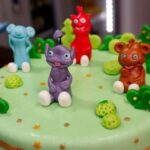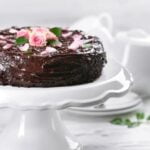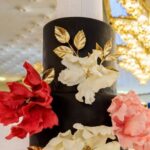Are you looking to elevate your baking skills and impress your friends and family with a beautifully decorated cake? In this article, we will delve into the art of creating decorative cakes, exploring essential tools, selecting the right cake recipe, baking perfect layers, choosing the best frosting and icing options, mastering intricate design techniques, incorporating edible decorations, and troubleshooting common issues.
By following our step-by-step guide, you’ll be well on your way to showcasing a stunning and delicious masterpiece at your next special occasion.
One of the most rewarding experiences in baking is crafting a decorative cake that not only tastes amazing but also looks visually appealing. With the right tools and equipment at hand, along with a good understanding of different cake recipes and decorating techniques, you can unleash your creativity and bring your sweet creations to life.
Whether you’re a novice baker or have some experience in cake decorating, this guide will provide valuable insights on how to make a decorative cake that stands out from the rest.
From selecting the ideal frosting to creating intricate designs on your cakes using various piping techniques, there are endless possibilities when it comes to decorating cakes. By following our comprehensive advice and tips for troubleshooting common issues that may arise during the process, you’ll be equipped to tackle any challenges that come your way. Get ready to showcase your artistic flair and create a show-stopping centerpiece that will leave everyone marveling at your skills in making decorative cakes.
Essential Tools and Equipment for Decorating Cakes
Decorating a cake can bring out the artistic flair in anyone, but having the right tools and equipment is essential to achieve professional-looking results. To create a decorative cake that wows your guests, invest in some key items. A good-quality turntable is a must-have for smooth frosting application and easy cake decoration.
Offset spatulas in various sizes are also important for spreading icing and creating designs on your cake layers. Piping bags and tips allow you to add intricate details and designs with precision.
In addition to basic tools, investing in specialty equipment can take your cake decorating skills to the next level. A bench scraper or icing smoother helps create clean, smooth surfaces on your cake. Decorating combs can add texture or patterns to your frosted cakes.
Stencils and airbrush kits are great for achieving detailed designs and adding colorful accents to your creations. With the right tools at your disposal, you’ll be well-equipped to bring your decorative cake visions to life.
Now that you have all the necessary tools and equipment, it’s time to put them to use in creating a stunning decorative cake. From piping flowers to creating intricate patterns, mastering the art of decorating cakes requires practice and patience. Experiment with different techniques using your tools until you find what works best for you.
With dedication and creativity, you’ll soon be able to showcase beautifully decorated cakes that will impress any crowd. Remember, practice makes perfect when it comes to mastering how to make a decorative cake.
Choosing the Right Cake Recipe for Decoration
When it comes to making a decorative cake, choosing the right cake recipe is crucial. The type of cake you use as your base will determine the overall taste, texture, and structure of your creation. Some cakes are better suited for elaborate decorations, while others may be more delicate or crumbly.
Consider the Occasion and Flavor
Before selecting a cake recipe, consider the occasion for which you are baking the decorative cake. Whether it’s for a birthday, wedding, or other special event, the flavor of the cake should complement the theme. For example, a rich chocolate cake may be perfect for a decadent celebration, while a light and fluffy sponge cake could be ideal for a springtime gathering.
Texture and Stability Matter
Another important factor to consider when choosing a cake recipe for decoration is the texture and stability of the cake. A sturdy cake with a tight crumb structure will hold up better to intricate designs and heavy layers of frosting. Avoid using overly moist or delicate cakes that might not support the weight of your decorations.
Experiment With Different Recipes
Don’t be afraid to experiment with different cake recipes to find one that suits your preferences and decorating style. Try baking various types of cakes, from classic vanilla buttercream to rich red velvet, until you discover the perfect base for your decorative creations. Remember that practice makes perfect when it comes to honing your skills on how to make a decorative cake.
Step-by-Step Guide on Baking the Perfect Cake Layers
Baking the perfect cake layers is a crucial step in creating a beautifully decorated cake. To start, make sure you have all the essential tools and equipment ready, such as mixing bowls, measuring cups and spoons, a mixer, and cake pans. Preheat your oven to the specified temperature in the cake recipe you’ve chosen.
Next, it’s important to choose the right cake recipe for decoration. Whether you prefer a classic vanilla or chocolate cake or something more unique like red velvet or lemon, ensure that the recipe you choose is suitable for layering and frosting. Follow the recipe instructions carefully to ensure that your cake layers turn out moist and fluffy.
Once your batter is mixed and ready to go, evenly divide it among your cake pans and smooth out the tops with a spatula. Remember to tap the pans on a flat surface before placing them in the oven to remove any air bubbles.
Bake the cakes according to the recommended time in your recipe, being careful not to overbake them. Use a toothpick inserted into the center of each layer to check for doneness – it should come out clean when they’re ready.
By following these steps diligently, you’ll be well on your way to baking perfect cake layers for decorating. The key is patience and attention to detail when it comes to this crucial aspect of creating a stunning decorative cake. With practice and determination, you’ll soon master this art and be able to showcase your beautifully baked creations for all to enjoy.
Types of Frosting and Icing for Decorative Cakes
When it comes to creating a beautifully decorated cake, choosing the right frosting and icing is crucial. These elements not only add flavor but also serve as the canvas for your decorative designs. Here are some popular types of frosting and icing that you can use to make your cake truly exceptional:
1. Buttercream Frosting: Buttercream is one of the most versatile and widely-used frostings for decorative cakes. Made from butter, powdered sugar, and flavorings, buttercream can be easily tinted with food coloring to achieve vibrant colors. It is perfect for piping designs, flowers, and borders on cakes.
2. Fondant: Fondant is a smooth, pliable icing that can be rolled out and draped over cakes to create a flawless finish. It is ideal for creating intricate designs, covering sculpted cakes, and achieving a polished look. While fondant may not be as tasty as buttercream, it offers a clean canvas for creative decorations.
3. Royal Icing: Royal icing is a hard-drying icing made from powdered sugar and egg whites or meringue powder. This type of icing is often used for delicate decorations such as intricate piping work, lace patterns, or intricate details like flowers or figures on cakes.
Ultimately how you choose to decorate your cake will depend on the style you want to achieve and your personal preferences in terms of taste and texture. Experimenting with different types of frosting and icing can help you discover which works best for your decorative cake creations.
By mastering these different types of frosting and icing, you can elevate your cake decorating skills and create stunning show-stopping desserts that are sure to impress any audience.
Techniques for Creating Intricate Designs on Cakes
Creating intricate designs on cakes is a skill that can take your decorative cake to the next level. There are several techniques that you can use to add beautiful and intricate details to your creation. One popular technique is piping, which involves using a pastry bag and different tips to pipe frosting onto the cake in various patterns and shapes. You can create swirls, rosettes, flowers, and even intricate lace designs using this method.
Another technique for creating intricate designs on cakes is using fondant. Fondant is a smooth, pliable icing that can be rolled out and shaped into various decorations such as bows, ribbons, and even figurines. With fondant, you can create elaborate designs that are sure to impress your guests. You can also use fondant cutters and molds to create more detailed decorations with ease.
If you want to take your cake decorating skills to the next level, consider learning how to do brush embroidery or stenciling on your cakes. Brush embroidery involves using a paintbrush to create delicate floral patterns on the surface of the cake using royal icing or buttercream.
Stenciling allows you to easily transfer intricate designs onto the cake by using a stencil and spreading icing or powdered sugar over it. Both techniques can add a touch of elegance and sophistication to your decorative cake.
By mastering these techniques for creating intricate designs on cakes, you will be able to elevate your cake decorating game and impress your friends and family with beautifully decorated creations. Experiment with different methods, practice regularly, and don’t be afraid to get creative with your designs. With patience and dedication, you’ll soon be able to make decorative cakes that are both visually stunning and deliciously satisfying for any occasion.
Tips for Using Edible Decorations and Embellishments
Decorating a cake is not just about frosting and icing; edible decorations and embellishments play a crucial role in taking your creation to the next level. From fondant flowers to chocolate ganache drizzles, these elements can truly make a decorative cake stand out. Here are some helpful tips on incorporating edible decorations and embellishments into your cake design:
Choosing the Right Edible Decorations
When it comes to selecting edible decorations for your cake, consider the theme and style you are aiming for. Fondant accents work well for elegant designs, while colorful sprinkles are perfect for fun and playful cakes. Edible pearls, sugar flowers, and even edible glitter can add a touch of glamor to your creation. Make sure to choose decorations that complement the flavors of your cake as well.
Placement and Design
Once you have chosen your edible decorations, it’s important to carefully plan their placement on the cake. Consider creating a rough sketch or design layout before you start decorating. Pay attention to symmetry, color balance, and spacing when placing embellishments on the cake. Whether you’re creating a whimsical birthday cake or an elaborate wedding masterpiece, thoughtful placement of edible decorations can enhance the overall look of your creation.
Experiment With Different Techniques
Don’t be afraid to get creative with your edible decorations. Try using different techniques such as piping buttercream flowers, sculpting fondant figures, or painting with food coloring on royal icing. Experimenting with various methods can help you discover new ways to elevate your decorative cakes. Remember, practice makes perfect, so don’t hesitate to try out different techniques until you find what works best for your unique style.
By following these tips for using edible decorations and embellishments on your cakes, you can create stunning masterpieces that will impress any crowd. Whether you’re a novice baker or an experienced pastry chef, incorporating these elements into your designs will elevate your decorative cakes to new heights. Don’t be afraid to unleash your creativity and experiment with different techniques – after all, half the fun of baking is in the decoration.
Troubleshooting Common Issues When Decorating Cakes
Decorating cakes can be a fun and rewarding experience, but sometimes things don’t go as planned. From cracked fondant to runny frosting, here are some common issues you may encounter while decorating a cake and how to troubleshoot them:
1. Cracked Fondant: One of the most common problems when working with fondant is it cracking or tearing. To prevent this issue, make sure your fondant is at room temperature before rolling it out. If cracks do occur, gently smooth them out with a small amount of shortening on your finger or a fondant smoother.
2. Runny Frosting: If your frosting is too runny, it can be challenging to work with and may not hold its shape when piping designs onto the cake. To thicken up your frosting, try adding more powdered sugar a little at a time until you reach the desired consistency.
3. Air Bubbles in Icing: Air bubbles can create unsightly bumps and holes in your beautifully decorated cake. To avoid this issue, make sure to smooth out your icing as you apply it to the cake using a spatula or icing smoother. You can also gently tap the cake on the counter to help release any trapped air bubbles.
4. Uneven Layers: Sometimes cakes can bake unevenly, resulting in lopsided layers that are difficult to decorate. To fix this issue, use a serrated knife to level off each layer before stacking them on top of each other. This will ensure a smooth surface for decorating.
Remember, practice makes perfect when it comes to decorating cakes. Don’t get discouraged if things don’t turn out exactly as planned – just keep experimenting and trying new techniques until you find what works best for you.
Final Thoughts
Decorating cakes is truly an art form that allows for creativity and imagination to flourish. By following the steps outlined in this article, you can learn how to make a decorative cake that will not only taste delicious but also captivate your audience visually. From essential tools and equipment to choosing the right cake recipe and mastering various decorating techniques, there are plenty of aspects to consider when creating a stunning masterpiece.
One of the key takeaways from this guide is understanding the importance of practice and patience when it comes to decorating cakes. The step-by-step instructions on baking perfect cake layers, selecting the right frosting or icing, and incorporating intricate designs are all crucial components in achieving a professional-looking result. With dedication and a willingness to experiment with different methods, you can elevate your cake decorating skills and impress your friends and family with stunning confectionery creations.
In conclusion, learning how to make a decorative cake is an enjoyable journey that requires time, effort, and a passion for baking. Whether you are a beginner or have some experience in cake decorating, there is always room for improvement and new techniques to explore. So grab your tools, whip up your favorite cake recipe, and let your creativity run wild as you embark on the wonderful world of making beautifully decorated cakes.
Frequently Asked Questions
How to Make a Cake Good for Decorating?
Making a cake that is good for decorating involves starting with a sturdy base. This means baking a dense cake that can hold up to the weight of frosting and decorations.
It’s important to let the cake cool completely before decorating to prevent melting or sliding of decorations. Leveling the cake layers, applying a crumb coat of frosting, and chilling the cake are also essential steps to ensure a smooth surface for decorating.
What Are the Ingredients Used to Decorate Cake?
Various ingredients are used to decorate cakes, depending on the desired design. Common ingredients include buttercream frosting, fondant, royal icing, gum paste, edible glitter or sprinkles, chocolate ganache, fresh fruits or flowers, and piping gel for creating intricate designs. Each ingredient offers different textures and finishes that can elevate the overall appearance of the cake.
What Are the 7 Different Cake Decorating Techniques?
There are several different cake decorating techniques that can be used to create stunning designs. Some popular techniques include piping borders or intricate designs using buttercream or royal icing, using fondant to cover the entire cake and create detailed decorations like flowers or figurines, creating texture with tools like offset spatulas or combs, stenciling patterns onto cakes using powdered sugar or edible coloring spray, painting designs with food coloring directly onto the cake surface, and using edible prints or images on cakes for more complex designs.
Each technique requires practice and skill to master but can result in beautiful and professional-looking decorated cakes.

Welcome to my blog about home and family. This blog is a place where I will share my thoughts, ideas, and experiences related to these important topics. I am a stay-at-home mom with two young children. I hope you enjoy reading it! and may find some helpful tips and ideas that will make your home and family life even better!





